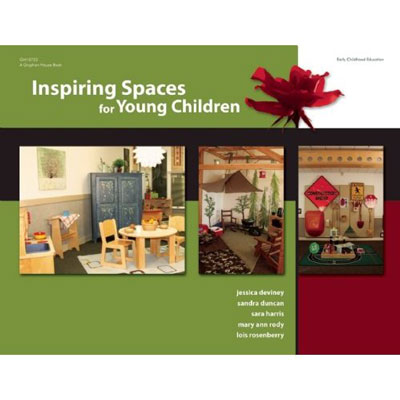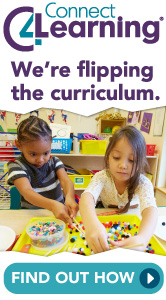ExchangeEveryDay Past Issues
 << Previous Issue
| View Past Issues | | Next Issue >>
<< Previous Issue
| View Past Issues | | Next Issue >> -Anne Frank, The Diary of a Young Girl, 1942
A recent study, reported by NBC News, has found that for young children, adopting a more subdued approach to classroom decoration has merit. The study was one of the first to examine how decorations impact learning. It found that when kindergartners were taught in a highly decorated classroom, they were more distracted and scored lower on tests than when they were taught in a room with bare walls.
"Researchers at Carnegie Mellon University followed a group of 24 kindergartners taught in two simulated classrooms: one with bare walls, the other decorated with commercial materials like presidential photos, science posters and maps, as well as the children’s artwork. During the lessons, children sat on carpet squares in a semicircle facing the teacher, who read aloud from a picture book. They participated in six lessons of five- to seven-minutes each in which the teacher read aloud on topics such as plate tectonics, the Solar System and bugs. After each lesson, the children took multiple-choice picture tests. Lessons were observed and videotaped to monitor how often the children were focused on the teacher or 'off task,' distracted by themselves, other students or the visual environment.
"In the sparse classroom, the kindergartners got distracted by other students or even themselves. But in the decorated one, children were more likely to be distracted by the visual environment and spent far more time 'off task.' Anna V. Fisher, the study’s lead author and an associate psychology professor, said the findings showed that the classroom environment can be distracting and negatively impact learning."
Contributed by Kirsten Haugen
|
Buy Inspiring Spaces and get a FREE downloadable PDF Exchange Essential of your choice ($10 value). Take these simple steps at check out:
|
|
Offer valid through February 11, 2017 at 11:59 pm Pacific Time. |






Comments (12)
Displaying All 12 CommentsLeonard Enterprises
Susquehanna, Pennsylvania, United States
I wonder what presidents were on the wall and what other commercial stuff? Plate tectonics, bla bla bla, they talk about that in kindergarten now? really? I bet one of the kids asked for it. Excuse me Mrs. Blender, Billy, Rashaad, and I were discussing plate tectonics and how it might affect the environment, gravity and stuff, oh and our marble games when we play with steelies. Would you teach us next week? What do you mean, "marbles are too dangerous for children my age"? You give me those back, I know how to build an EMP device and I will. C'mon some of those were my grandpa's. I been collecting since I was 3. Mommeeeeee...
.
Leonard Enterprises
Susquehanna, Pennsylvania, United States
I thank God I was at home with Gramma and Grampa, learning to be free and entrepreneurial at these childrens age. Has anyone noticed, oh yes someone mentioned prison, that the takeover from parents and local community of "education"(spelled prepared for us to use), happened about the same time as the industrial revolution? Im going to go watch "The Wall" again.
Sunshine Cornerd, Inc
Strasburg, PA, United States
This theory is just sad. A bare wall is institutional and haven't we tried to get away from this type of setting in ECE and kindergarten? Children should have color in their lives!
Intersquare
United States
I suppose that studies show that children learn better in prison settings, then inside the classroom. Seem that bars and gray walls were less distracting then chalk boards, ABC decorations and such.
Sponsored by
Comfortable Prisons, We are more than just Cells!
Seattle, WA, United States
When did "time on task" become a goal for young children? When do hildren select their own tasks? When do they get to have their own thoughts in an enriched environment? The researchers' goal sounds like training for the reptilian brain. Small mammals like decorations on their walls.
Discovery Schoolhouse, Inc.
Milton, Ma, United States
While it is certainly true that wall decorations (as well as many other things) can distract from "time on learning," one must first consider what it is that one wants the children to learn and how they can best learn it. For kindergartens, it is clear from experience and overwhelming research that a teacher instructing a group as described, while very occasionally appropriate, is just about the worst way to teach young children anything. So, to conclude that the decorations distracted children from this otherwise very dubious "time on learning" is really missing the point. I'm no fan of the "cute" decorations so many teachers and parents seem to want and expect in a kindergarten classroom, but thoughtful, appropriate, interesting materials in a developmentally appropriate, child-centered classroom actually encourage learning by drawing children in, and not "distracting" them. If the materials on the walls are so much more enticing than the teacher and the book, then perhaps the teacher needs to reevaluate the lesson he was trying to teach and the way he was trying to teach it. Additionally, the decorations could be made more relevant to the subject of the lesson, so that children would see examples of what the book was about all around them, and the the subject would be not only be reinforced, but also presented in a variety of modes and be more available to a greater range of children. Long after the book was done, children would continual finding relevant information all around them (and many would have already gained some familiarity with the subject before the "lesson" even began). If the researcher's conclusion is that silly, cute, frivolous, and unnecessary decorations can distract children, or anyone, from other tasks, then I would agree, but I hardly think a study was required to confirm this fundamental and obvious human experience.
Illinois Central College
Normal, Illinois, United States
I am 'so not surprised' by the findings of the Carnegie Mellon University study. I noted that you indicate that the walls in one classroom were 'commercial materials.' I believe there is a direct connection with the distraction factor and the commercialization of children.
I do believe some aesthetic materials on walls will enhance thinking. It's a fine line between commercialized material - even the children's work (what was it?) - and materials that provoke thought. I look forward to a follow up study.
United States
Okay - 24 kindergarteners and one group of researchers come up, they believe, with data that supports the notion that kindergarteners in a "highly decorated classroom, ... were more distracted and scored lower on tests than when they were taught in a room with bare walls." What classifies as a distraction? or as being off task? My experience as a human being shows that when some think I am distracted or off-task - the truth is I'm doing exactly what I need to do to accomplish my work. Of course, I'm an adult. I think teachers and children should co-create the classroom as is needed for them, and the rest of us maybe can go back to doing our own work.
That said, I happen to be someone who kind of likes bare walls - but that's me and that's me some of the time, not all of the time.
I don't think this piece of research is worthy of sharing yet as the sample size is too small. There should also be a link to the study itself so the rest of us can see the criteria upon which it is based.
Little Bears Learning Center
Washington , NJ, United States
Another topic over analyzed in early childhood. My students in pre -k for over 20 years have done fine with the many decorations on the walls and elsewhere in the classroom. They were nurtured , loved, and presented with engaging activities every day and most have done just fine. The children that may have had any difficulty I am sure was not due to my decorations. Let children be children, love them and let them learn by play. Thank you for the opportunity to comment.
retired
Canada
In other words, kindergartners are learning from their environment rather than being taught at. This age group should be learning from what is around them rather than sitting quietly listening to a lesson. Isn't that what we are talking about all the time now. Learn through play, the environment as the 3rd teacher, it's the process not the product. These should be the tenets of education. There is much written about this and I firmly believe learning should be done on an individual basis through play and from the environment.
CSBC
Denver, CO, United States
Sounds good; just like a jail. Maybe this is why there are so many fights and inter-personal conflicts in jail! Seriously, I always tell my college students that one of the things we need to be teaching our children is how to sort out important information from irrelevant stimuli. Ever listened to all the commercials on the radio as you drive to work, or sat through all the TV commercials? Life is not a bare wall!
Pennsylvania, United States
Children in my class love to decorate the walls with their creations---It gives them great pride and we have so many discussions about what is on the walls (child made and store-bought). Again, this seems to be more of a discussion about whether as teachers we are supporting the children's interests or working too hard to impose a pre-set, formal curriculum on them
Post a Comment